Case Study: Improving Employee Engagement at Birmingham City Council
VerifiedAdded on 2023/01/03
|8
|2377
|97
Case Study
AI Summary
This case study examines Birmingham City Council's (BCC) implementation of the BEST policy, a strategy designed to improve employee engagement and address HR challenges. The report critically evaluates BCC's approach, highlighting the use of the Zinger model and the impact on employee motivation and pride. It discusses the organizational, leadership, and individual inputs of the Zinger model, and how BCC adapted it through the BEST program. The study further identifies future HR challenges, such as implementing change and flexible working arrangements, and recommends strategies to tackle these issues, including the application of Lewin's Change Management Model and the development of effective training sessions and communication strategies. The conclusion emphasizes the continuous nature of employee engagement and the importance of addressing future challenges proactively.
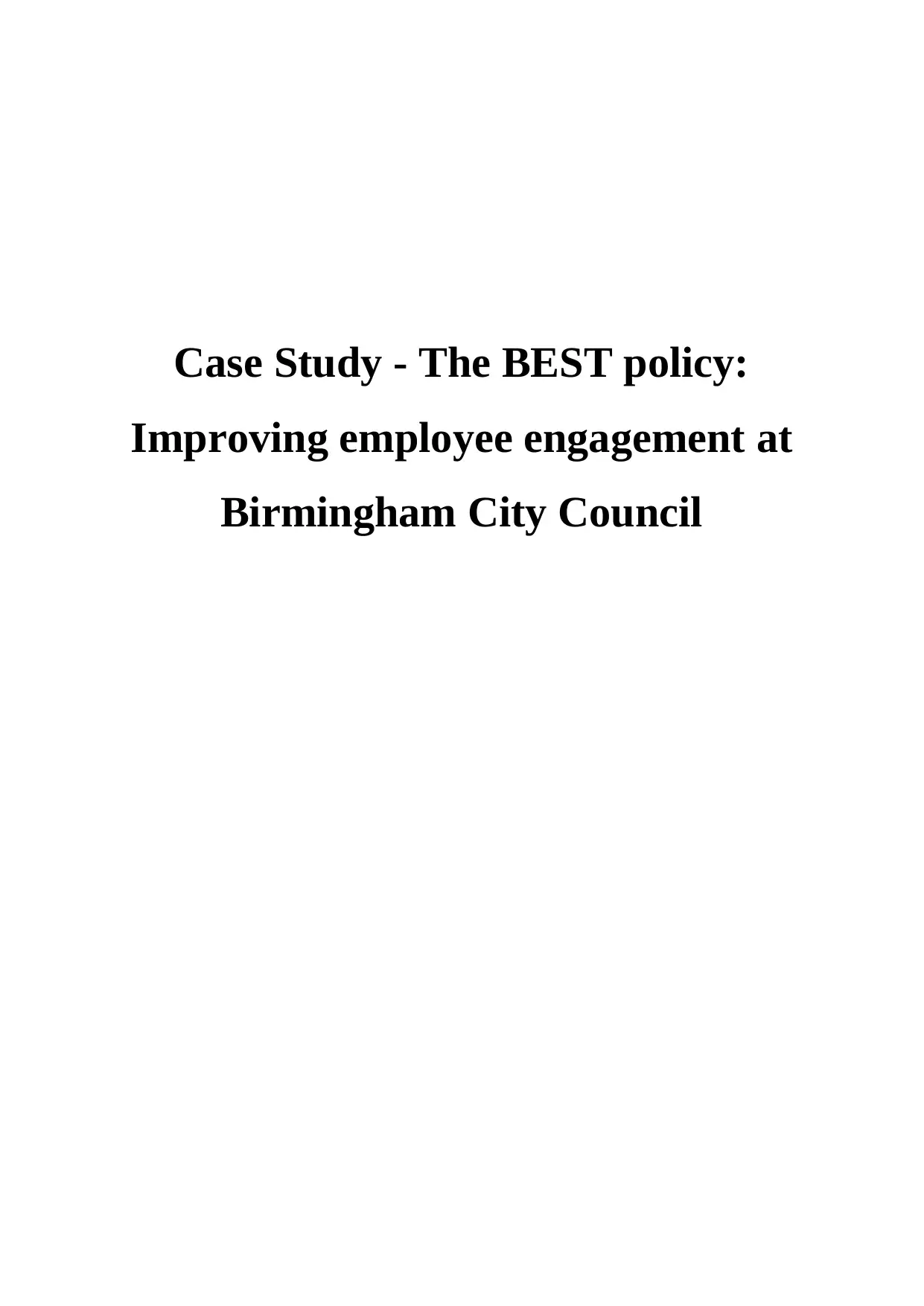
Case Study - The BEST policy:
Improving employee engagement at
Birmingham City Council
Improving employee engagement at
Birmingham City Council
Paraphrase This Document
Need a fresh take? Get an instant paraphrase of this document with our AI Paraphraser
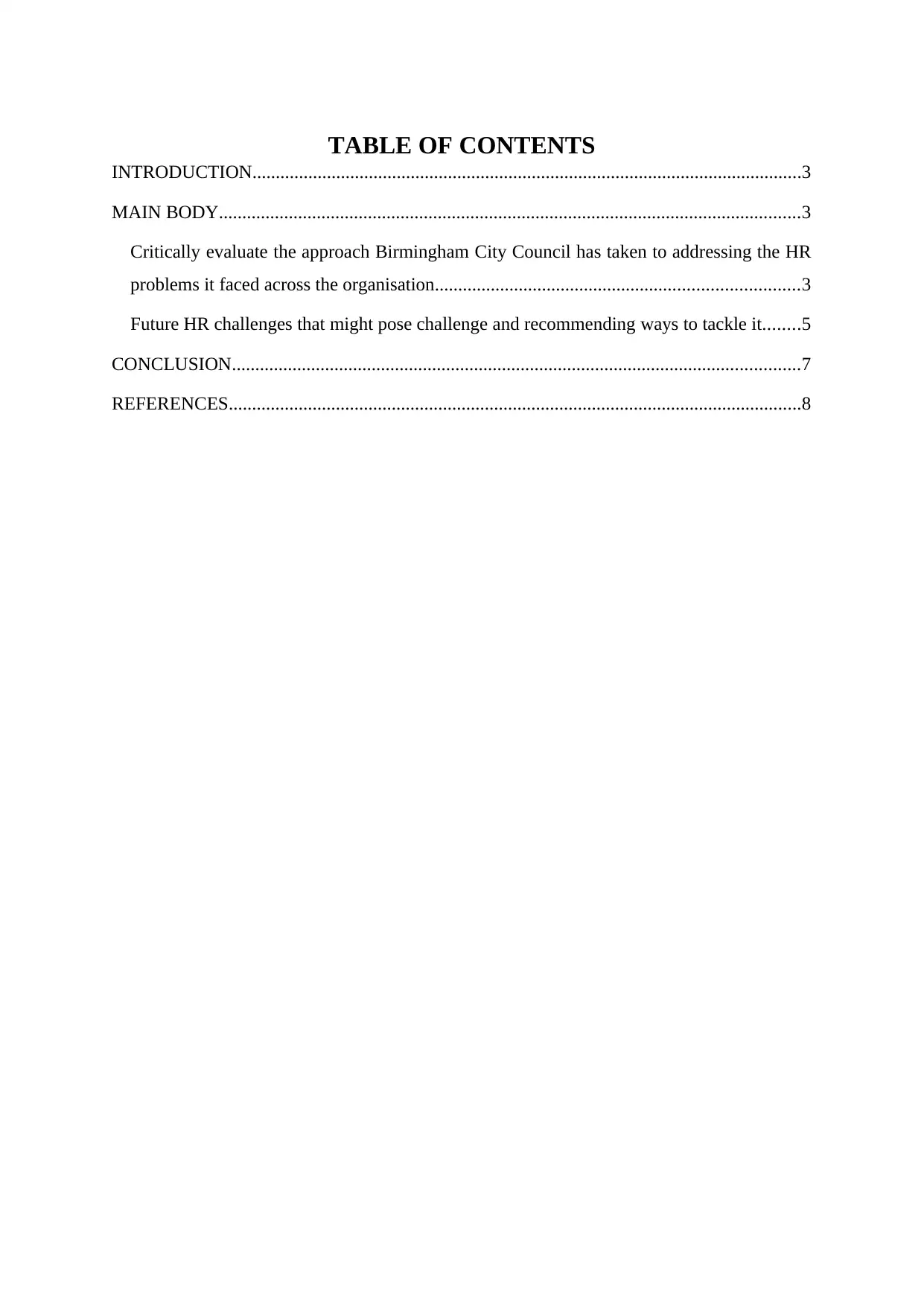
TABLE OF CONTENTS
INTRODUCTION......................................................................................................................3
MAIN BODY.............................................................................................................................3
Critically evaluate the approach Birmingham City Council has taken to addressing the HR
problems it faced across the organisation..............................................................................3
Future HR challenges that might pose challenge and recommending ways to tackle it........5
CONCLUSION..........................................................................................................................7
REFERENCES...........................................................................................................................8
INTRODUCTION......................................................................................................................3
MAIN BODY.............................................................................................................................3
Critically evaluate the approach Birmingham City Council has taken to addressing the HR
problems it faced across the organisation..............................................................................3
Future HR challenges that might pose challenge and recommending ways to tackle it........5
CONCLUSION..........................................................................................................................7
REFERENCES...........................................................................................................................8
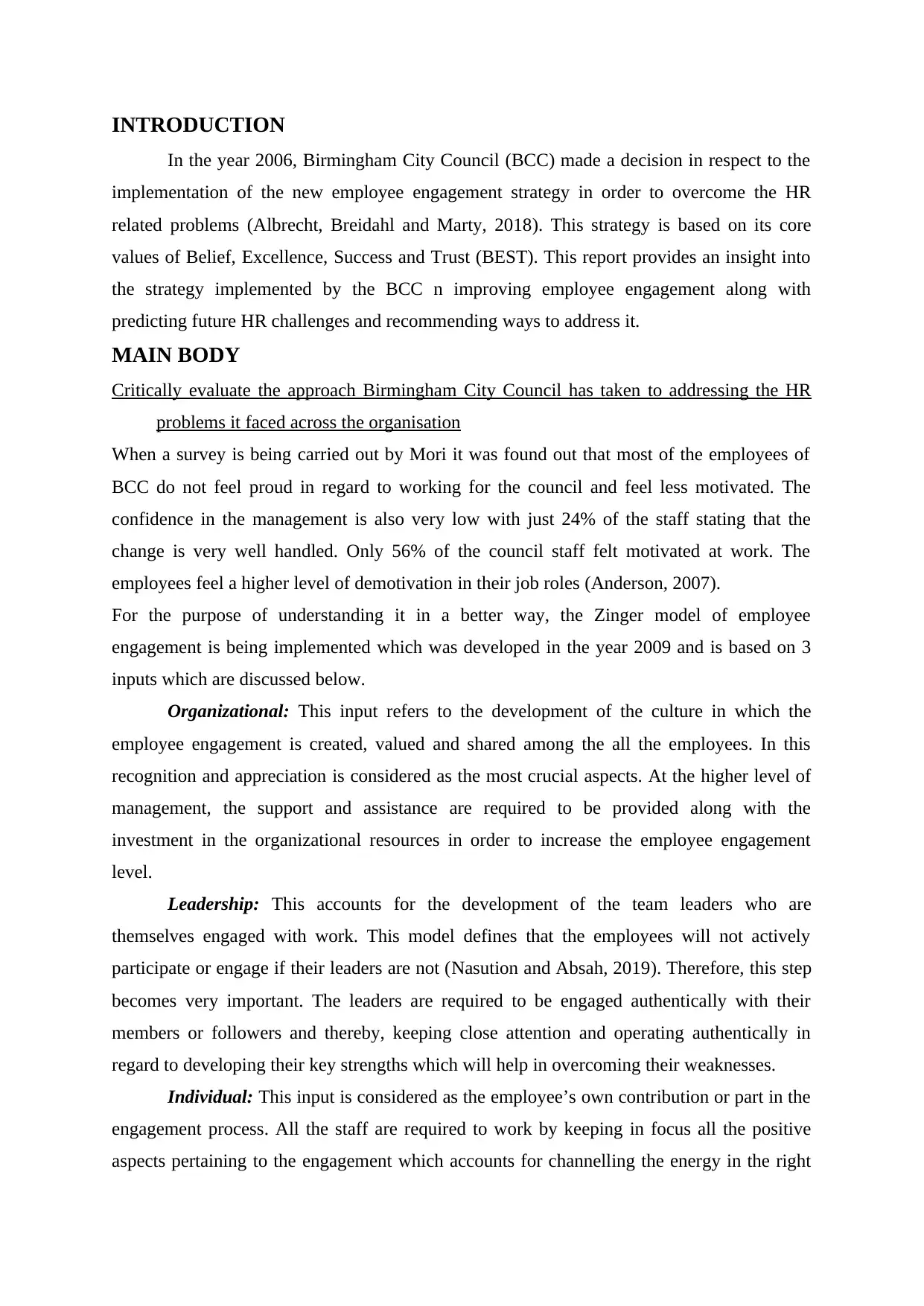
INTRODUCTION
In the year 2006, Birmingham City Council (BCC) made a decision in respect to the
implementation of the new employee engagement strategy in order to overcome the HR
related problems (Albrecht, Breidahl and Marty, 2018). This strategy is based on its core
values of Belief, Excellence, Success and Trust (BEST). This report provides an insight into
the strategy implemented by the BCC n improving employee engagement along with
predicting future HR challenges and recommending ways to address it.
MAIN BODY
Critically evaluate the approach Birmingham City Council has taken to addressing the HR
problems it faced across the organisation
When a survey is being carried out by Mori it was found out that most of the employees of
BCC do not feel proud in regard to working for the council and feel less motivated. The
confidence in the management is also very low with just 24% of the staff stating that the
change is very well handled. Only 56% of the council staff felt motivated at work. The
employees feel a higher level of demotivation in their job roles (Anderson, 2007).
For the purpose of understanding it in a better way, the Zinger model of employee
engagement is being implemented which was developed in the year 2009 and is based on 3
inputs which are discussed below.
Organizational: This input refers to the development of the culture in which the
employee engagement is created, valued and shared among the all the employees. In this
recognition and appreciation is considered as the most crucial aspects. At the higher level of
management, the support and assistance are required to be provided along with the
investment in the organizational resources in order to increase the employee engagement
level.
Leadership: This accounts for the development of the team leaders who are
themselves engaged with work. This model defines that the employees will not actively
participate or engage if their leaders are not (Nasution and Absah, 2019). Therefore, this step
becomes very important. The leaders are required to be engaged authentically with their
members or followers and thereby, keeping close attention and operating authentically in
regard to developing their key strengths which will help in overcoming their weaknesses.
Individual: This input is considered as the employee’s own contribution or part in the
engagement process. All the staff are required to work by keeping in focus all the positive
aspects pertaining to the engagement which accounts for channelling the energy in the right
In the year 2006, Birmingham City Council (BCC) made a decision in respect to the
implementation of the new employee engagement strategy in order to overcome the HR
related problems (Albrecht, Breidahl and Marty, 2018). This strategy is based on its core
values of Belief, Excellence, Success and Trust (BEST). This report provides an insight into
the strategy implemented by the BCC n improving employee engagement along with
predicting future HR challenges and recommending ways to address it.
MAIN BODY
Critically evaluate the approach Birmingham City Council has taken to addressing the HR
problems it faced across the organisation
When a survey is being carried out by Mori it was found out that most of the employees of
BCC do not feel proud in regard to working for the council and feel less motivated. The
confidence in the management is also very low with just 24% of the staff stating that the
change is very well handled. Only 56% of the council staff felt motivated at work. The
employees feel a higher level of demotivation in their job roles (Anderson, 2007).
For the purpose of understanding it in a better way, the Zinger model of employee
engagement is being implemented which was developed in the year 2009 and is based on 3
inputs which are discussed below.
Organizational: This input refers to the development of the culture in which the
employee engagement is created, valued and shared among the all the employees. In this
recognition and appreciation is considered as the most crucial aspects. At the higher level of
management, the support and assistance are required to be provided along with the
investment in the organizational resources in order to increase the employee engagement
level.
Leadership: This accounts for the development of the team leaders who are
themselves engaged with work. This model defines that the employees will not actively
participate or engage if their leaders are not (Nasution and Absah, 2019). Therefore, this step
becomes very important. The leaders are required to be engaged authentically with their
members or followers and thereby, keeping close attention and operating authentically in
regard to developing their key strengths which will help in overcoming their weaknesses.
Individual: This input is considered as the employee’s own contribution or part in the
engagement process. All the staff are required to work by keeping in focus all the positive
aspects pertaining to the engagement which accounts for channelling the energy in the right
⊘ This is a preview!⊘
Do you want full access?
Subscribe today to unlock all pages.

Trusted by 1+ million students worldwide
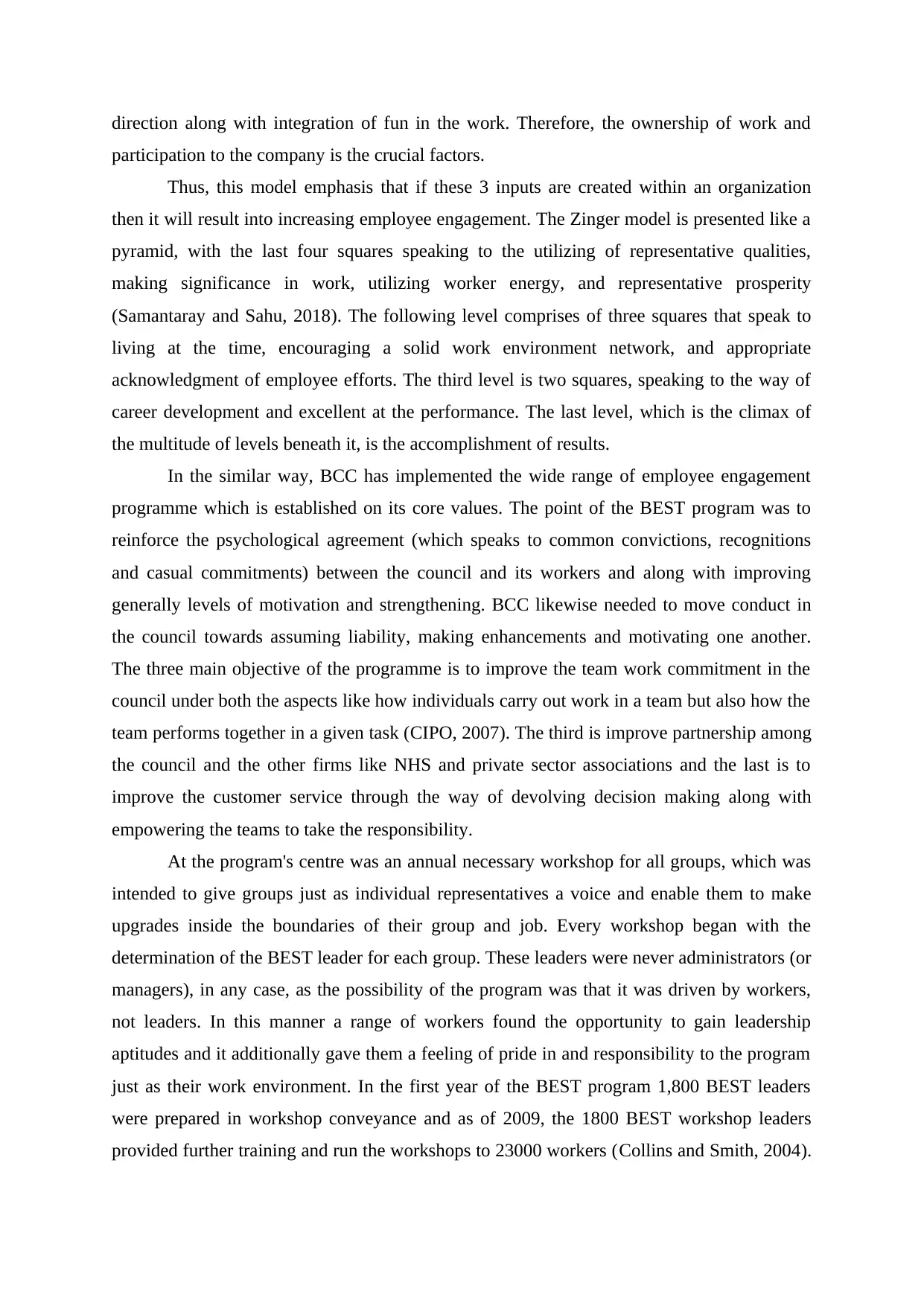
direction along with integration of fun in the work. Therefore, the ownership of work and
participation to the company is the crucial factors.
Thus, this model emphasis that if these 3 inputs are created within an organization
then it will result into increasing employee engagement. The Zinger model is presented like a
pyramid, with the last four squares speaking to the utilizing of representative qualities,
making significance in work, utilizing worker energy, and representative prosperity
(Samantaray and Sahu, 2018). The following level comprises of three squares that speak to
living at the time, encouraging a solid work environment network, and appropriate
acknowledgment of employee efforts. The third level is two squares, speaking to the way of
career development and excellent at the performance. The last level, which is the climax of
the multitude of levels beneath it, is the accomplishment of results.
In the similar way, BCC has implemented the wide range of employee engagement
programme which is established on its core values. The point of the BEST program was to
reinforce the psychological agreement (which speaks to common convictions, recognitions
and casual commitments) between the council and its workers and along with improving
generally levels of motivation and strengthening. BCC likewise needed to move conduct in
the council towards assuming liability, making enhancements and motivating one another.
The three main objective of the programme is to improve the team work commitment in the
council under both the aspects like how individuals carry out work in a team but also how the
team performs together in a given task (CIPO, 2007). The third is improve partnership among
the council and the other firms like NHS and private sector associations and the last is to
improve the customer service through the way of devolving decision making along with
empowering the teams to take the responsibility.
At the program's centre was an annual necessary workshop for all groups, which was
intended to give groups just as individual representatives a voice and enable them to make
upgrades inside the boundaries of their group and job. Every workshop began with the
determination of the BEST leader for each group. These leaders were never administrators (or
managers), in any case, as the possibility of the program was that it was driven by workers,
not leaders. In this manner a range of workers found the opportunity to gain leadership
aptitudes and it additionally gave them a feeling of pride in and responsibility to the program
just as their work environment. In the first year of the BEST program 1,800 BEST leaders
were prepared in workshop conveyance and as of 2009, the 1800 BEST workshop leaders
provided further training and run the workshops to 23000 workers (Collins and Smith, 2004).
participation to the company is the crucial factors.
Thus, this model emphasis that if these 3 inputs are created within an organization
then it will result into increasing employee engagement. The Zinger model is presented like a
pyramid, with the last four squares speaking to the utilizing of representative qualities,
making significance in work, utilizing worker energy, and representative prosperity
(Samantaray and Sahu, 2018). The following level comprises of three squares that speak to
living at the time, encouraging a solid work environment network, and appropriate
acknowledgment of employee efforts. The third level is two squares, speaking to the way of
career development and excellent at the performance. The last level, which is the climax of
the multitude of levels beneath it, is the accomplishment of results.
In the similar way, BCC has implemented the wide range of employee engagement
programme which is established on its core values. The point of the BEST program was to
reinforce the psychological agreement (which speaks to common convictions, recognitions
and casual commitments) between the council and its workers and along with improving
generally levels of motivation and strengthening. BCC likewise needed to move conduct in
the council towards assuming liability, making enhancements and motivating one another.
The three main objective of the programme is to improve the team work commitment in the
council under both the aspects like how individuals carry out work in a team but also how the
team performs together in a given task (CIPO, 2007). The third is improve partnership among
the council and the other firms like NHS and private sector associations and the last is to
improve the customer service through the way of devolving decision making along with
empowering the teams to take the responsibility.
At the program's centre was an annual necessary workshop for all groups, which was
intended to give groups just as individual representatives a voice and enable them to make
upgrades inside the boundaries of their group and job. Every workshop began with the
determination of the BEST leader for each group. These leaders were never administrators (or
managers), in any case, as the possibility of the program was that it was driven by workers,
not leaders. In this manner a range of workers found the opportunity to gain leadership
aptitudes and it additionally gave them a feeling of pride in and responsibility to the program
just as their work environment. In the first year of the BEST program 1,800 BEST leaders
were prepared in workshop conveyance and as of 2009, the 1800 BEST workshop leaders
provided further training and run the workshops to 23000 workers (Collins and Smith, 2004).
Paraphrase This Document
Need a fresh take? Get an instant paraphrase of this document with our AI Paraphraser
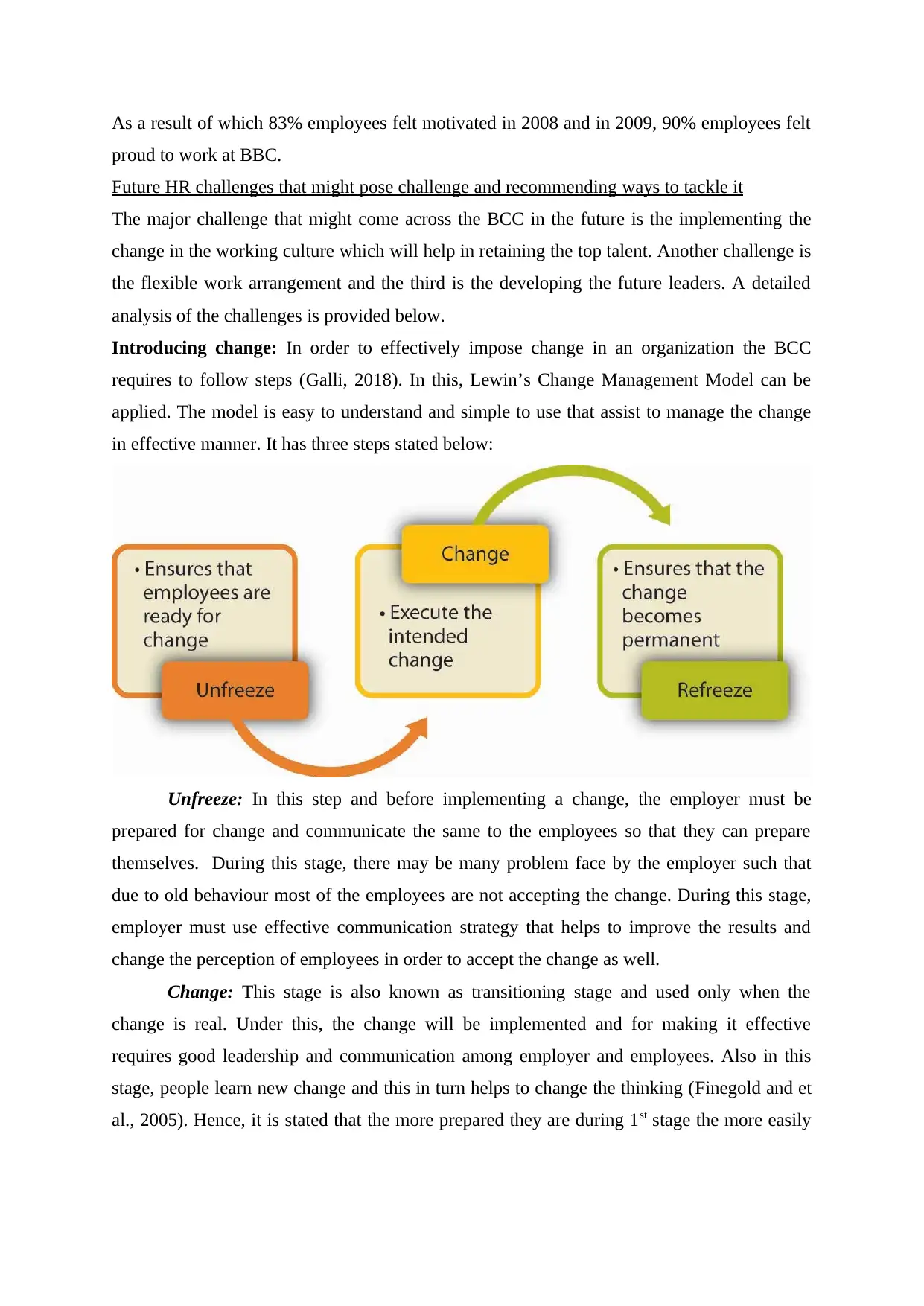
As a result of which 83% employees felt motivated in 2008 and in 2009, 90% employees felt
proud to work at BBC.
Future HR challenges that might pose challenge and recommending ways to tackle it
The major challenge that might come across the BCC in the future is the implementing the
change in the working culture which will help in retaining the top talent. Another challenge is
the flexible work arrangement and the third is the developing the future leaders. A detailed
analysis of the challenges is provided below.
Introducing change: In order to effectively impose change in an organization the BCC
requires to follow steps (Galli, 2018). In this, Lewin’s Change Management Model can be
applied. The model is easy to understand and simple to use that assist to manage the change
in effective manner. It has three steps stated below:
Unfreeze: In this step and before implementing a change, the employer must be
prepared for change and communicate the same to the employees so that they can prepare
themselves. During this stage, there may be many problem face by the employer such that
due to old behaviour most of the employees are not accepting the change. During this stage,
employer must use effective communication strategy that helps to improve the results and
change the perception of employees in order to accept the change as well.
Change: This stage is also known as transitioning stage and used only when the
change is real. Under this, the change will be implemented and for making it effective
requires good leadership and communication among employer and employees. Also in this
stage, people learn new change and this in turn helps to change the thinking (Finegold and et
al., 2005). Hence, it is stated that the more prepared they are during 1st stage the more easily
proud to work at BBC.
Future HR challenges that might pose challenge and recommending ways to tackle it
The major challenge that might come across the BCC in the future is the implementing the
change in the working culture which will help in retaining the top talent. Another challenge is
the flexible work arrangement and the third is the developing the future leaders. A detailed
analysis of the challenges is provided below.
Introducing change: In order to effectively impose change in an organization the BCC
requires to follow steps (Galli, 2018). In this, Lewin’s Change Management Model can be
applied. The model is easy to understand and simple to use that assist to manage the change
in effective manner. It has three steps stated below:
Unfreeze: In this step and before implementing a change, the employer must be
prepared for change and communicate the same to the employees so that they can prepare
themselves. During this stage, there may be many problem face by the employer such that
due to old behaviour most of the employees are not accepting the change. During this stage,
employer must use effective communication strategy that helps to improve the results and
change the perception of employees in order to accept the change as well.
Change: This stage is also known as transitioning stage and used only when the
change is real. Under this, the change will be implemented and for making it effective
requires good leadership and communication among employer and employees. Also in this
stage, people learn new change and this in turn helps to change the thinking (Finegold and et
al., 2005). Hence, it is stated that the more prepared they are during 1st stage the more easily
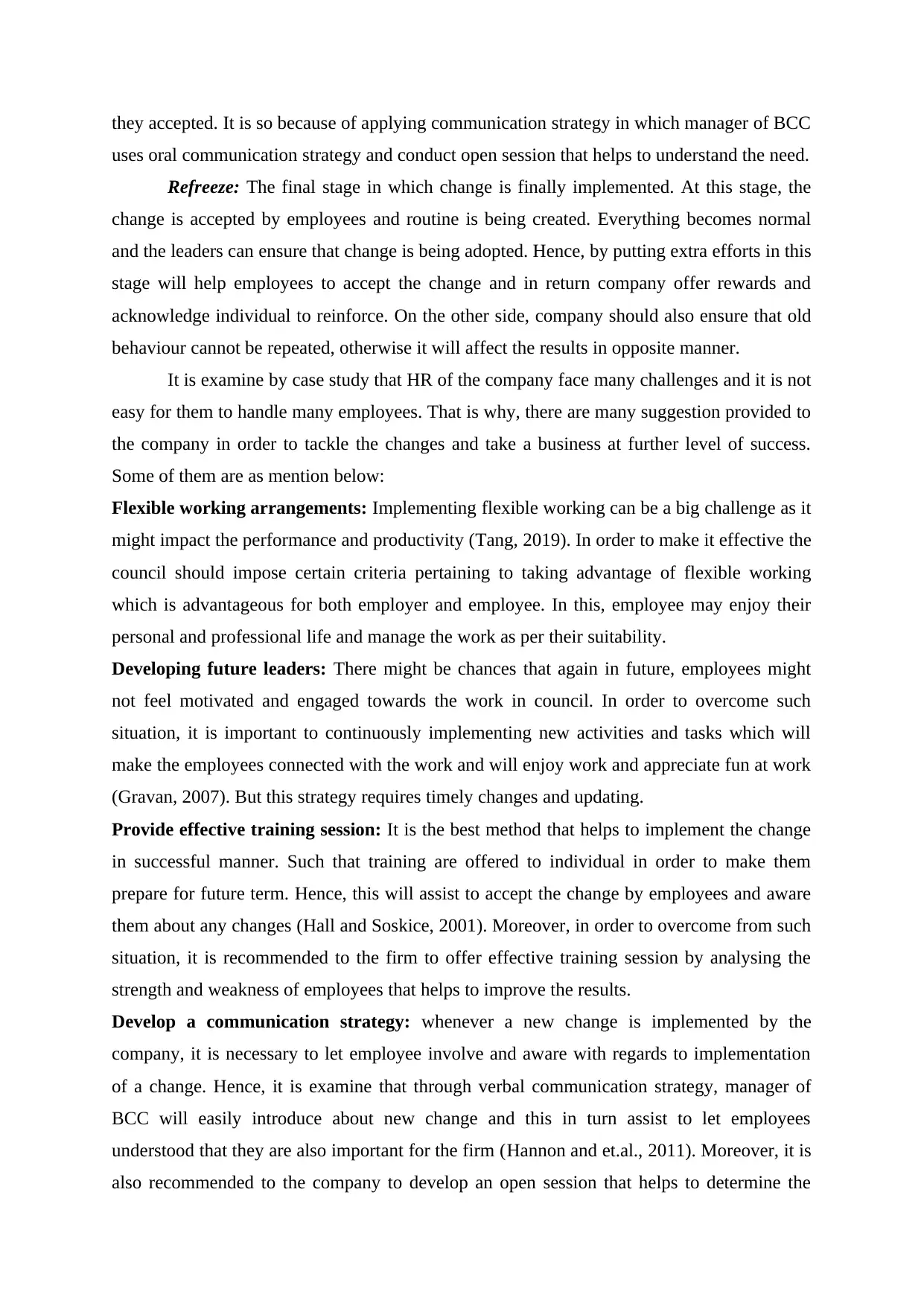
they accepted. It is so because of applying communication strategy in which manager of BCC
uses oral communication strategy and conduct open session that helps to understand the need.
Refreeze: The final stage in which change is finally implemented. At this stage, the
change is accepted by employees and routine is being created. Everything becomes normal
and the leaders can ensure that change is being adopted. Hence, by putting extra efforts in this
stage will help employees to accept the change and in return company offer rewards and
acknowledge individual to reinforce. On the other side, company should also ensure that old
behaviour cannot be repeated, otherwise it will affect the results in opposite manner.
It is examine by case study that HR of the company face many challenges and it is not
easy for them to handle many employees. That is why, there are many suggestion provided to
the company in order to tackle the changes and take a business at further level of success.
Some of them are as mention below:
Flexible working arrangements: Implementing flexible working can be a big challenge as it
might impact the performance and productivity (Tang, 2019). In order to make it effective the
council should impose certain criteria pertaining to taking advantage of flexible working
which is advantageous for both employer and employee. In this, employee may enjoy their
personal and professional life and manage the work as per their suitability.
Developing future leaders: There might be chances that again in future, employees might
not feel motivated and engaged towards the work in council. In order to overcome such
situation, it is important to continuously implementing new activities and tasks which will
make the employees connected with the work and will enjoy work and appreciate fun at work
(Gravan, 2007). But this strategy requires timely changes and updating.
Provide effective training session: It is the best method that helps to implement the change
in successful manner. Such that training are offered to individual in order to make them
prepare for future term. Hence, this will assist to accept the change by employees and aware
them about any changes (Hall and Soskice, 2001). Moreover, in order to overcome from such
situation, it is recommended to the firm to offer effective training session by analysing the
strength and weakness of employees that helps to improve the results.
Develop a communication strategy: whenever a new change is implemented by the
company, it is necessary to let employee involve and aware with regards to implementation
of a change. Hence, it is examine that through verbal communication strategy, manager of
BCC will easily introduce about new change and this in turn assist to let employees
understood that they are also important for the firm (Hannon and et.al., 2011). Moreover, it is
also recommended to the company to develop an open session that helps to determine the
uses oral communication strategy and conduct open session that helps to understand the need.
Refreeze: The final stage in which change is finally implemented. At this stage, the
change is accepted by employees and routine is being created. Everything becomes normal
and the leaders can ensure that change is being adopted. Hence, by putting extra efforts in this
stage will help employees to accept the change and in return company offer rewards and
acknowledge individual to reinforce. On the other side, company should also ensure that old
behaviour cannot be repeated, otherwise it will affect the results in opposite manner.
It is examine by case study that HR of the company face many challenges and it is not
easy for them to handle many employees. That is why, there are many suggestion provided to
the company in order to tackle the changes and take a business at further level of success.
Some of them are as mention below:
Flexible working arrangements: Implementing flexible working can be a big challenge as it
might impact the performance and productivity (Tang, 2019). In order to make it effective the
council should impose certain criteria pertaining to taking advantage of flexible working
which is advantageous for both employer and employee. In this, employee may enjoy their
personal and professional life and manage the work as per their suitability.
Developing future leaders: There might be chances that again in future, employees might
not feel motivated and engaged towards the work in council. In order to overcome such
situation, it is important to continuously implementing new activities and tasks which will
make the employees connected with the work and will enjoy work and appreciate fun at work
(Gravan, 2007). But this strategy requires timely changes and updating.
Provide effective training session: It is the best method that helps to implement the change
in successful manner. Such that training are offered to individual in order to make them
prepare for future term. Hence, this will assist to accept the change by employees and aware
them about any changes (Hall and Soskice, 2001). Moreover, in order to overcome from such
situation, it is recommended to the firm to offer effective training session by analysing the
strength and weakness of employees that helps to improve the results.
Develop a communication strategy: whenever a new change is implemented by the
company, it is necessary to let employee involve and aware with regards to implementation
of a change. Hence, it is examine that through verbal communication strategy, manager of
BCC will easily introduce about new change and this in turn assist to let employees
understood that they are also important for the firm (Hannon and et.al., 2011). Moreover, it is
also recommended to the company to develop an open session that helps to determine the
⊘ This is a preview!⊘
Do you want full access?
Subscribe today to unlock all pages.

Trusted by 1+ million students worldwide
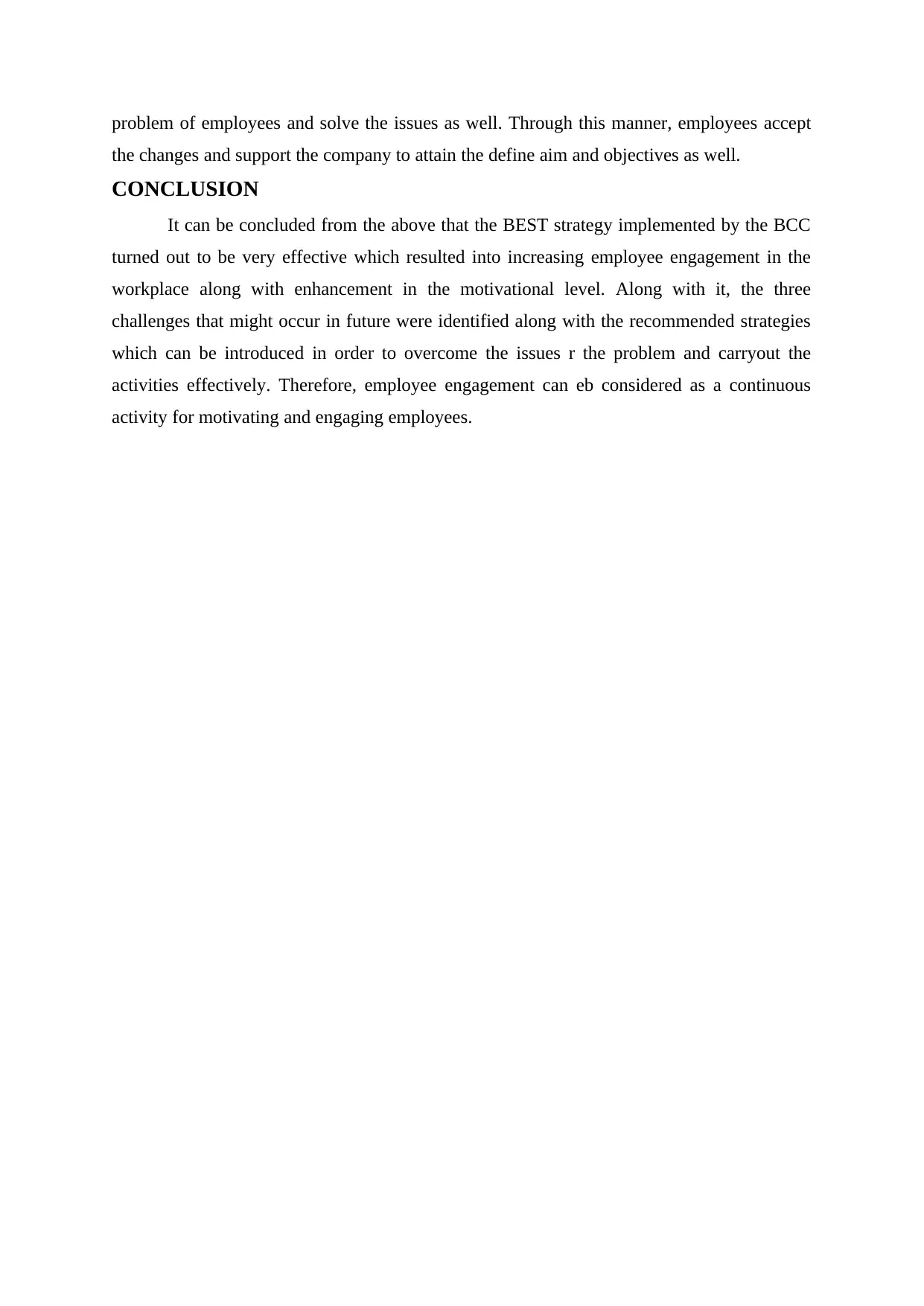
problem of employees and solve the issues as well. Through this manner, employees accept
the changes and support the company to attain the define aim and objectives as well.
CONCLUSION
It can be concluded from the above that the BEST strategy implemented by the BCC
turned out to be very effective which resulted into increasing employee engagement in the
workplace along with enhancement in the motivational level. Along with it, the three
challenges that might occur in future were identified along with the recommended strategies
which can be introduced in order to overcome the issues r the problem and carryout the
activities effectively. Therefore, employee engagement can eb considered as a continuous
activity for motivating and engaging employees.
the changes and support the company to attain the define aim and objectives as well.
CONCLUSION
It can be concluded from the above that the BEST strategy implemented by the BCC
turned out to be very effective which resulted into increasing employee engagement in the
workplace along with enhancement in the motivational level. Along with it, the three
challenges that might occur in future were identified along with the recommended strategies
which can be introduced in order to overcome the issues r the problem and carryout the
activities effectively. Therefore, employee engagement can eb considered as a continuous
activity for motivating and engaging employees.
Paraphrase This Document
Need a fresh take? Get an instant paraphrase of this document with our AI Paraphraser
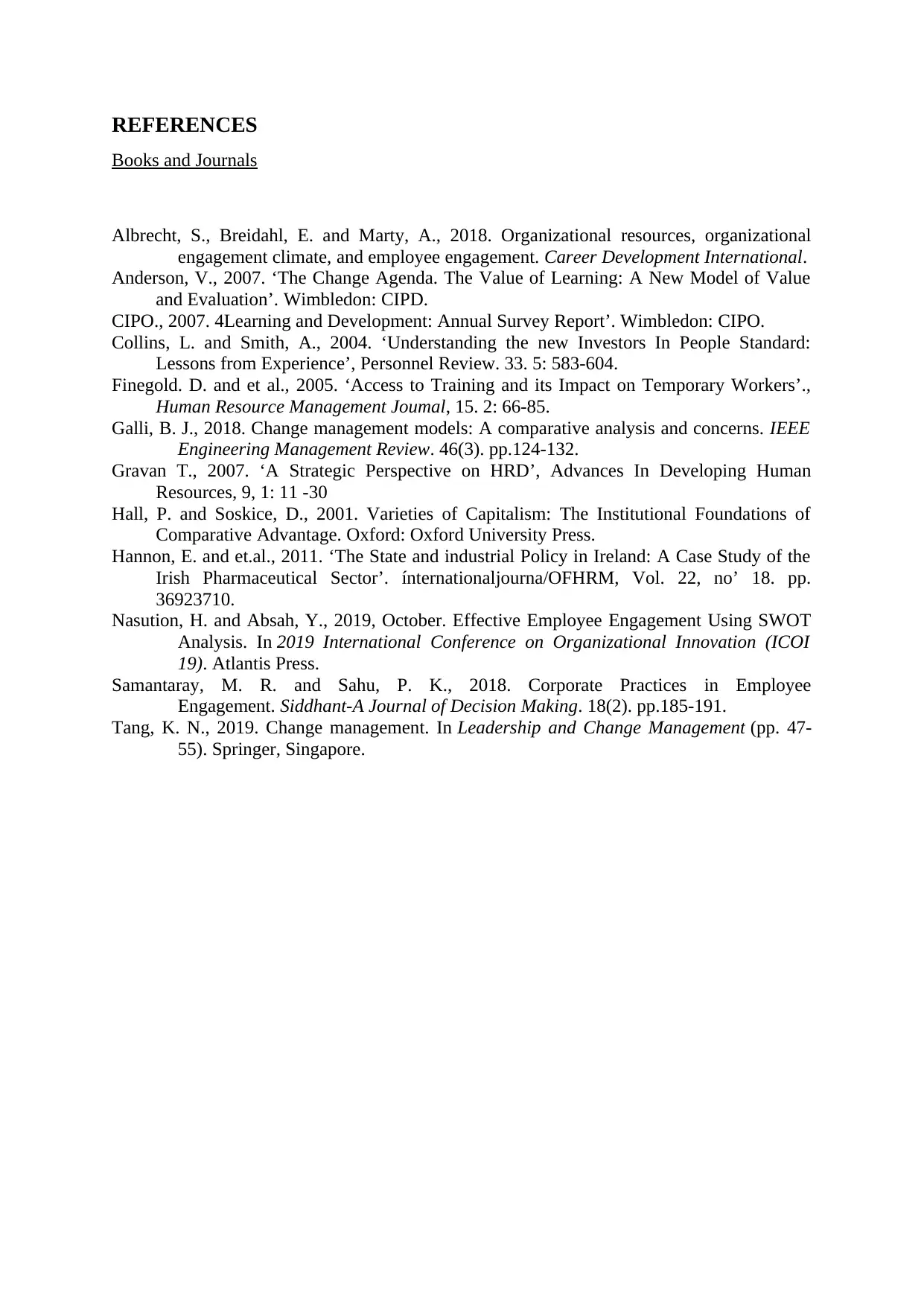
REFERENCES
Books and Journals
Albrecht, S., Breidahl, E. and Marty, A., 2018. Organizational resources, organizational
engagement climate, and employee engagement. Career Development International.
Anderson, V., 2007. ‘The Change Agenda. The Value of Learning: A New Model of Value
and Evaluation’. Wimbledon: CIPD.
CIPO., 2007. 4Learning and Development: Annual Survey Report’. Wimbledon: CIPO.
Collins, L. and Smith, A., 2004. ‘Understanding the new Investors In People Standard:
Lessons from Experience’, Personnel Review. 33. 5: 583-604.
Finegold. D. and et al., 2005. ‘Access to Training and its Impact on Temporary Workers’.,
Human Resource Management Joumal, 15. 2: 66-85.
Galli, B. J., 2018. Change management models: A comparative analysis and concerns. IEEE
Engineering Management Review. 46(3). pp.124-132.
Gravan T., 2007. ‘A Strategic Perspective on HRD’, Advances In Developing Human
Resources, 9, 1: 11 -30
Hall, P. and Soskice, D., 2001. Varieties of Capitalism: The Institutional Foundations of
Comparative Advantage. Oxford: Oxford University Press.
Hannon, E. and et.al., 2011. ‘The State and industrial Policy in Ireland: A Case Study of the
Irish Pharmaceutical Sector’. ínternationaljourna/OFHRM, Vol. 22, no’ 18. pp.
36923710.
Nasution, H. and Absah, Y., 2019, October. Effective Employee Engagement Using SWOT
Analysis. In 2019 International Conference on Organizational Innovation (ICOI
19). Atlantis Press.
Samantaray, M. R. and Sahu, P. K., 2018. Corporate Practices in Employee
Engagement. Siddhant-A Journal of Decision Making. 18(2). pp.185-191.
Tang, K. N., 2019. Change management. In Leadership and Change Management (pp. 47-
55). Springer, Singapore.
Books and Journals
Albrecht, S., Breidahl, E. and Marty, A., 2018. Organizational resources, organizational
engagement climate, and employee engagement. Career Development International.
Anderson, V., 2007. ‘The Change Agenda. The Value of Learning: A New Model of Value
and Evaluation’. Wimbledon: CIPD.
CIPO., 2007. 4Learning and Development: Annual Survey Report’. Wimbledon: CIPO.
Collins, L. and Smith, A., 2004. ‘Understanding the new Investors In People Standard:
Lessons from Experience’, Personnel Review. 33. 5: 583-604.
Finegold. D. and et al., 2005. ‘Access to Training and its Impact on Temporary Workers’.,
Human Resource Management Joumal, 15. 2: 66-85.
Galli, B. J., 2018. Change management models: A comparative analysis and concerns. IEEE
Engineering Management Review. 46(3). pp.124-132.
Gravan T., 2007. ‘A Strategic Perspective on HRD’, Advances In Developing Human
Resources, 9, 1: 11 -30
Hall, P. and Soskice, D., 2001. Varieties of Capitalism: The Institutional Foundations of
Comparative Advantage. Oxford: Oxford University Press.
Hannon, E. and et.al., 2011. ‘The State and industrial Policy in Ireland: A Case Study of the
Irish Pharmaceutical Sector’. ínternationaljourna/OFHRM, Vol. 22, no’ 18. pp.
36923710.
Nasution, H. and Absah, Y., 2019, October. Effective Employee Engagement Using SWOT
Analysis. In 2019 International Conference on Organizational Innovation (ICOI
19). Atlantis Press.
Samantaray, M. R. and Sahu, P. K., 2018. Corporate Practices in Employee
Engagement. Siddhant-A Journal of Decision Making. 18(2). pp.185-191.
Tang, K. N., 2019. Change management. In Leadership and Change Management (pp. 47-
55). Springer, Singapore.
1 out of 8
Related Documents
Your All-in-One AI-Powered Toolkit for Academic Success.
+13062052269
info@desklib.com
Available 24*7 on WhatsApp / Email
![[object Object]](/_next/static/media/star-bottom.7253800d.svg)
Unlock your academic potential
Copyright © 2020–2025 A2Z Services. All Rights Reserved. Developed and managed by ZUCOL.




